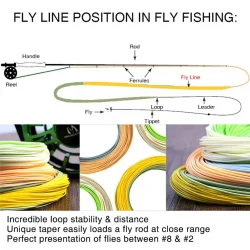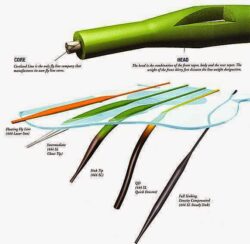Fly lines have come a long way. The first fly lines were made from waxed and braided horse tail hair. Sinew from deer was used for the tippets. Hooks were made one at a time. Daniel Webster and the early fly guys loved to fish a brace,3, wet flies. Times have changed.
Modern fly lines are made from more durable materials. PVC is coated over a braided thread to make a custom line. Remember, a fly line must be heavier to cast a fly. Fly Casting is about throwing a line. The fly just goes along for the ride. You get what you pay for with fly lines.
Several manufacturers make consistent quality products. Look at Rio, Orvis, Cortland, and Scientific Anglers for a great choice.
Not all lines are the same shape or serve the same function. Some fly lines float, due to air bubbles in the line. Other lines have a lead or tungsten core to make them sink. This would be perfect for fishing deep with nymphs or streamers. Dry fly guys prefer a floating line.
Not every day is perfect for casting. This means that you need a weight forward or Wind cutter fly line on windy days. Remember that the fly line is around 30 yards long. Once you are past the line, there is usually 100 yards or so of backing. The fly line contours its shape to be fatter in the front section than the back. The heavier front section casts easier and makes the rod work more efficiently to throw the line. The tippet, monofilament, simply travels with the fly line. The fly is at the terminal end of the leader.
Fly lines also come in level, weight forward, double taper, shooting tapers, and other specialty tapers. The lines need to match the “weight” of the fly rod. If you fish heavier flies and streamers, its ok to use a line one size up from the weight recommended on the rod blank.
You can make your fly line sink by using weights, sink tips, and weighted flies. A double taper or level line can be reversed after a few years to make your line like new again. Use some Armor All to clean and lubricate your line. Avoid stepping or knotting your fly line. Once the PVC coating is cracked, the line will leak and be less effective. Change fly lines every 5 or so years, depending upon use. If your line is older, you are missing out on better products and easier casting.
One thing most fly guys don’t consider is color. Many guys buy fly line that is brightly colored. Red, Orange, and hot colors. This allows them to see the line, but it also scares the fish. Try using white! Fish see in black and white, so the color of the sky appears white to them. This means that the white fly line is camouflaged.
90% of your fly fishing will be less than 20 yards. White line allows you to watch your cast, not spook the fish, and make more accurate casts.
One thing is for sure. Fly Fishermen are the most opinionated anglers on the planet. Everyone has their own idea about what works best. Find a mentor and become a student of the sport!
Montana Grant